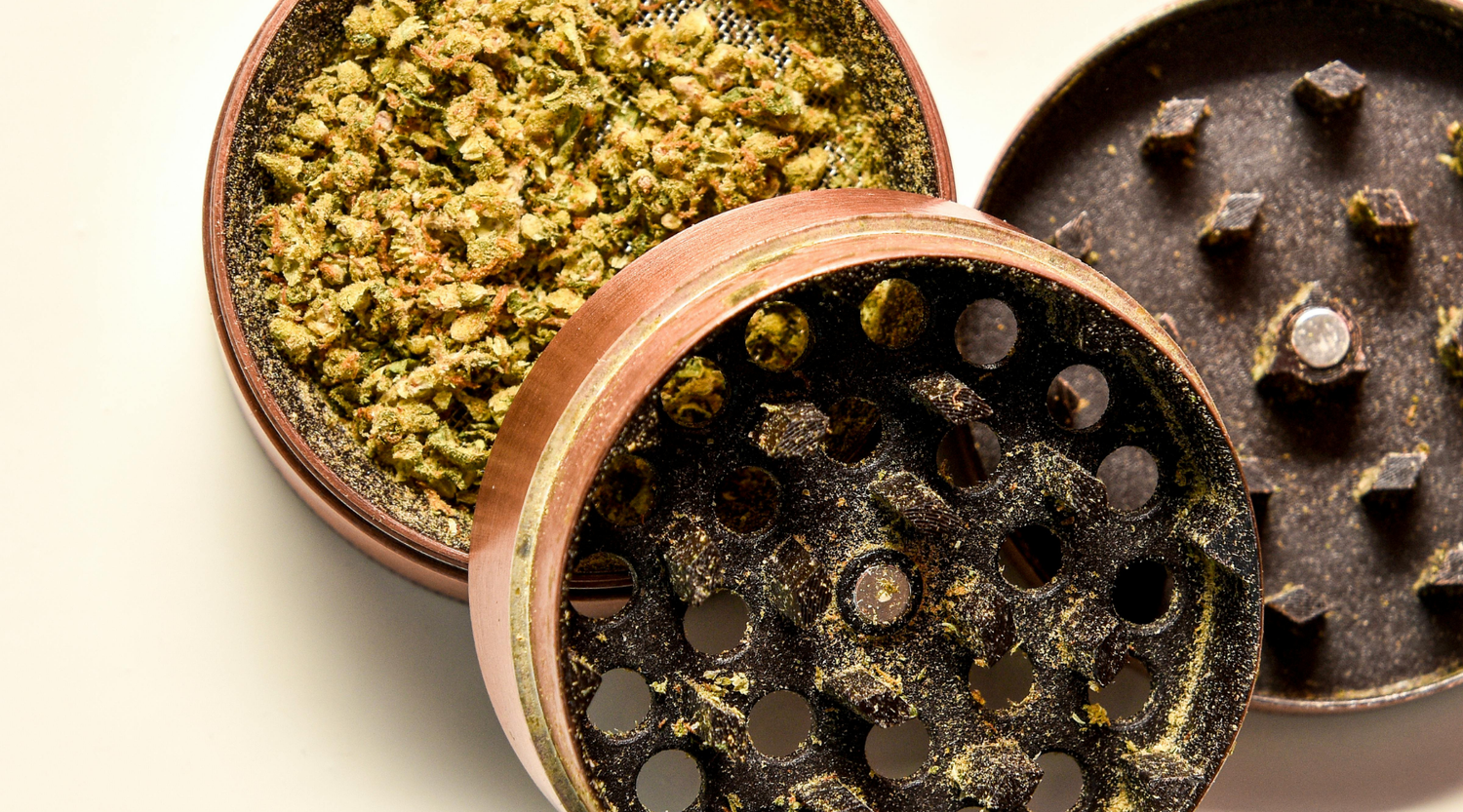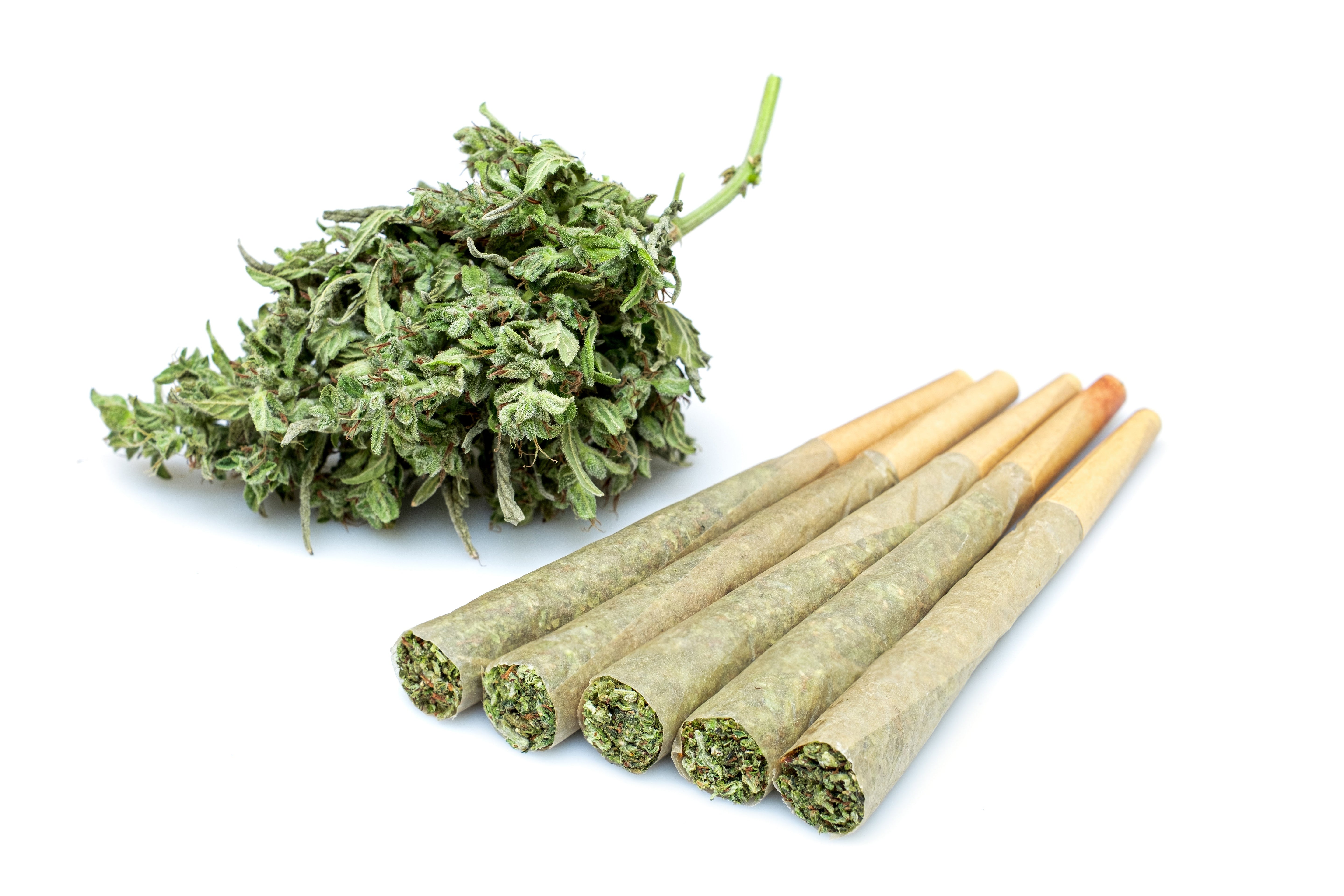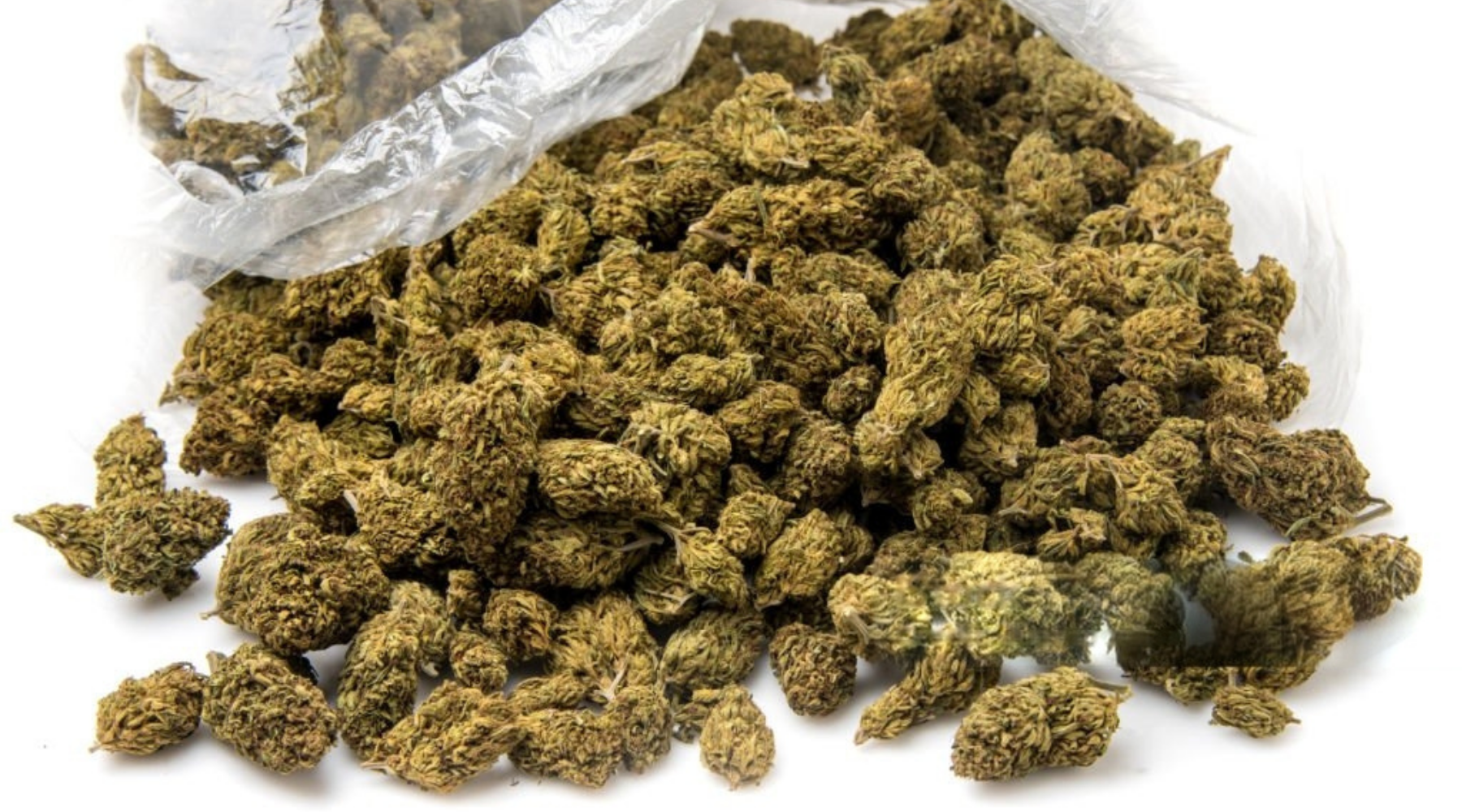You can have the stickiest, most potent flower out there. But if your grind is off, your whole session takes a hit. Ever sparked a pre-rolled cone or a joint that burned unevenly or packed a bowl that clogged halfway through? That’s not just bad luck. That’s bad prep.
And the difference between a smooth, flavorful experience and a frustrating one usually starts before you even light up.
Grinding might seem like a throwaway step, but it’s one of the most important parts of the ritual. Get it right, and your herb burns evenly, your airflow stays clean, and every hit delivers what it’s supposed to.
Get it wrong, and you’re fighting your gear, wasting weed, and wondering why the session just doesn’t feel right. The truth is, your grind sets the tone for everything that comes next.
That’s why taking the time to learn how to grind properly isn’t just helpful. It’s essential. Whether you’re rolling, packing, or vaping, the quality of your grind is what makes the whole experience work.
And before you even get into how to grind, it helps to understand why it matters so much in the first place.
Why Grinding Your Weed Matters
Most people think grinding is just a prep step. Something you do quickly before the real session starts. But the truth is, your grind sets the stage for everything that happens after. It’s the first point of contact between you and the flower.
If you do it right, your weed performs better, tastes better, and burns cleaner. Do it wrong, and you’ll find yourself wasting product, relighting constantly, or choking on uneven hits.
Grinding isn’t a throwaway step, it’s the foundation of a smooth, efficient smoke.
Enhances Flavor and Potency
Grinding your weed properly is one of the easiest ways to unlock its full potential. When you break up flower evenly, you’re exposing way more surface area to heat. This means more cannabinoids and terpenes are activated when it burns. That translates directly to stronger effects, better flavor, and an all-around smoother experience. If you're smoking dense nugs without grinding, you’re leaving good stuff behind.
That sticky resin and delicate terpene profile doesn’t stand a chance when it's locked inside a chunk that barely lights.
Flavor is where it really shows. With a clean grind, the heat distributes evenly and the terpenes get released in a controlled way. That’s when you start tasting the citrus, the earth, the pine. Whatever your strain is working with.
Without a proper grind, you end up scorching parts of the flower, which dulls the taste and gives you more of that burnt popcorn vibe. It’s not just about how strong the weed is; it’s about how clean and intentional the burn feels, from the first hit to the last.
And then there’s potency. Even if you’re smoking a top-shelf flower, grinding it unevenly can cut its impact in half. A joint packed with chunky bits and fine dust won't burn right, which means you’re wasting both product and potential. But when it’s ground evenly?
Every particle is pulling its weight. You get fuller hits, longer sessions, and a high that actually reflects what the strain was bred to do. If you're trying to stretch your stash while getting the most out of every bowl or cone, it starts here: with the grind.
Promotes Even Burn and Airflow
One of the biggest reasons to grind your weed properly is to control how it burns. If you’ve ever lit a packed pre-rolled cone or a joint that started canoeing, or hit a bowl that burned down one side while the other stayed untouched, you already know the frustration. That happens when the flower isn’t broken down evenly.
Big chunks take longer to burn, while tiny dust-like bits torch instantly. A good grind eliminates those extremes, giving you a consistent texture that helps the flower combust at the same rate.
When your weed is evenly ground, the airflow opens up naturally. Each pull feels smooth, and you’re not working your lungs just to get a decent hit. This is especially noticeable when you’re smoking joints or blunts.
Bad airflow means more relights, harsher drags, and an uneven high. A well-packed cone with the right grind? It hits clean, stays lit, and draws exactly the way you want it to. The same goes for bowls and pipes. Too tight, and you’re clogging up the chamber.
Too loose, and your hits get weak and airy. Grind consistency gives you airflow control, and airflow control gives you better smoke.
And it’s not just about comfort: it’s about efficiency. Uneven burning wastes weed. You're lighting one section while another barely ignites, meaning you’re not actually getting the most from your bud.
With a proper grind, the cherry moves steadily across the bowl or down the joint, letting you enjoy every bit of flower without constantly babysitting your gear.
When your grind is dialed in, you get more from less. That kind of control is what separates a frustrating session from a great one.
Maximizes Efficiency and Reduces Waste
I think any smoker out there will agree when we say, bud isn’t cheap. Whether you’re picking up top-shelf or just trying to make a mids bag stretch, wasting flower is never the goal. And grinding is where that efficiency starts. When you break your weed down properly, you control not just how much you're using, but how it's being used.
Unbroken nugs in a bowl or joint can burn unevenly, drop ash, or end up half-charred while the core stays untouched. That’s money going up in smoke. Like, literally.
With a consistent grind, every bit of flower is being exposed to heat evenly. You're not torching one part while the rest falls apart or flakes out of your paper. The burn is smoother, and you actually get to experience the full effect of your weed without wasting any of it.
It also makes rolling easier and more precise. No weird bulges, no loose ends, no flower falling out the sides when you spark up. You’re in control of the burn, the flow, and the flavor.
And it adds up. Over time, a consistent grind helps your stash last longer without compromising your high. You’ll find that you don’t need to load as much in your bowl or roll as fat to get the same effect. It’s a simple shift that saves you product and maximizes the impact of every sesh.
Less waste, more payoff. That’s the kind of ratio anyone can get behind. If you’re trying to stretch your weed and still enjoy the full experience, grinding right isn’t optional.
Choosing the Right Grinder
Not all grinders are built the same. And if you’ve ever used a cheap plastic one or tried to break down dense bud with your fingers, you know the struggle. The grinder you choose isn’t just about size or price.
It directly affects how smooth your grind is, how much product you preserve, and how clean your setup stays.
Whether you’re rolling on the go or prepping for a full session, picking the right tool makes the whole process easier and way more effective.
Two-Piece vs. Four-Piece Grinders
Two-piece grinders are the definition of simple. You load your bud, twist a few times, and you’re done. No compartments, no extras. Just teeth and a single chamber. They’re lightweight, easy to clean, and small enough to stash in your pocket without a second thought.
If you’re only breaking down a little at a time and don’t care about saving kief or pre-grinding for later, a two-piece gets the job done without overcomplicating it. For casual smokers or anyone who values minimalism, it’s a solid no-fuss option.
But if you’re someone who rolls frequently or cares about quality control, a four-piece grinder is a serious upgrade. These come with multiple chambers. One for grinding, one for catching your ground flower, and another for collecting kief that falls through a mesh screen.
That separation lets you grind more consistently, store what you’ve ground without dumping it everywhere, and slowly build up a stash of kief that would otherwise get lost in a two-piece.
It’s not just convenient. It’s efficient, especially if you like boosting potency or making the most out of every gram.
The real difference comes down to how much control you want over your grind. Two-piece grinders work, but they don’t give you the same consistency or storage flexibility.
A four-piece setup takes up a little more space, but gives you better results every time, especially if you’re grinding daily or prepping for longer sessions.
If you’re the kind of smoker who wants cleaner rolls, more even bowls, and that kief bonus building in the background, the four-piece earns its spot in your kit.
Manual vs. Electric Grinders
Manual grinders are for smokers who like control. With a manual setup, you’re hands-on. You load it, twist it, and feel the resistance as the bud breaks down. You can stop mid-grind, check the texture, and decide if you want it finer or chunkier depending on how you’re smoking.
It’s a more tactile experience, and once you know your gear, you can dial in the grind exactly how you want it. For a lot of people, that control is worth the effort, especially when you’re rolling joints or packing glass and need consistency to avoid burning issues.
Electric grinders flip the whole process into one step. Drop your flower in, hit the button, and let the machine take care of the rest. It’s faster and requires zero effort, which makes it perfect if you’ve got mobility issues, are prepping large amounts, or just don’t feel like twisting a metal grinder after a long day.
Some electric grinders even let you choose your grind setting. From coarse to fine, it gives you decent control without doing any of the physical work. They’re especially handy for vaping, where precise texture can make a big difference in how evenly your bud heats up.
That said, electric grinders have their flaws, especially if you’re not paying attention. They can easily overgrind your flower in a few seconds flat, turning your bud into powder that burns too fast or clogs your joint.
Unlike manual grinders, where you feel the resistance and can stop when it feels right, electric options take away that feedback. So if you’re using one, timing matters.
Quick pulses are better than long holds. Otherwise, you’ll go from fluffy grind to dust before you know it. If you want speed and convenience, electric grinders are great.
Just be ready to keep an eye on texture so your session doesn’t suffer.
Material Considerations: Metal, Plastic, or Wood
Metal grinders are the go-to for a reason. They’re durable, smooth to operate, and hold up under frequent use without dulling out or falling apart. Most are made from aluminum or stainless steel, which are both sturdy enough to shred dense nugs without getting jammed or gunked up too easily.
They also resist resin buildup better than wood or plastic, making them easier to clean and more reliable over time. And most importantly, metal doesn’t interfere with flavor. So, you’re tasting your bud, not your grinder.
Plastic grinders exist mostly for budget convenience. They’re cheap, lightweight, and easy to toss into a bag or use on the go. But they come with trade-offs. The teeth wear down quickly, especially if you’re grinding sticky flower. And some low-quality ones can even shed little plastic shavings into your herb if you twist too aggressively.
That’s not something you want ending up in your joint. They’ll get the job done in a pinch, but they’re definitely not built for long-term, daily use.
Wood grinders are the aesthetic pick. They’ve got a natural look, often carved or stained, and they feel a little more old-school in your hands. But when it comes to performance, they fall short. Wood holds onto moisture and resin, which makes the teeth gunk up quickly.
They’re also harder to clean, can get sticky fast, and often come with metal pegs instead of sharp teeth, so the grind isn’t as consistent. If you’re picking one up as a novelty or just for the look, cool. But if you're grinding regularly, metal is the smarter, cleaner, and way more functional option.
Shredding Machines
For high-volume grinding, shredding machines are in a league of their own. These aren't your standard grinders. They’re designed to process large batches of flower efficiently and consistently, producing uniform texture ideal for pre-roll production, bulk packaging, or regular heavy-use setups.
With motorized shredding and optimized blade configurations, they can take down dense nugs in seconds and leave you with a clean, consistent shred that’s ready for cones, bowls, or storage.
If you're looking to streamline your prep work and keep everything consistent from session to session, shredding machines are the tool for the job.
Depending on your needs, there are multiple sizes and setups available. Each offers a different balance of portability, output, and workflow compatibility.
Here's a breakdown of the most common formats:
Classic Mini
The Classic Mini Shredder is compact, portable, and built for smaller-scale operations. It’s ideal if you're prepping personal batches, organizing pre-rolls at home, or simply want something efficient without taking up too much space.
Don’t let the size fool you, it still delivers a consistent shred that beats hand-grinding for speed and output.
Classic OG
The Classic OG Shredder model gives you a balanced middle ground between size and capacity. It's made for users who want more processing power than a Mini but don’t need full-scale output.
Perfect for small production teams or serious solo users grinding several ounces at a time, the OG offers a dependable mix of speed, efficiency, and volume.
Classic Mega
The Classic Mega Shredder takes things up a notch. Built for large-scale shredding, this format excels when you're processing heavy batches in one go. Whether you're prepping for event-level sessions, managing large grow output, or need reliable bulk grinding, the Mega delivers both power and throughput at scale.
Super Shredder with Destemmer
The Super Shredder brings full workflow efficiency. It’s equipped with a destemmer and a sifter screen barrel, which helps streamline the process from raw nug to usable grind by removing stems and sorting the material at the same time.
Available in Mini, OG, and Mega sizes, this machine is made for users who want full control over output quality while maximizing consistency.
If your goal is to simplify prep, reduce manual labor, and produce a clean grind ready for whatever comes next, the Super Shredder setup checks every box.
A 4- Step Guide to Grinding Weed
Once you’ve got your grinder of choice and a bit of flower ready to go, it’s time to break it down, literally. Grinding might seem like a simple twist-and-go process, but doing it right takes more than just throwing a nug between some teeth.
From prepping your bud to knowing when to stop, each step matters if you want the best results.
Whether you’re brand new or just want to tighten up your routine, this guide walks you through each step to make sure your grind is clean, efficient, and ready to burn right, every time.
Step 1: Prepare Your Herb
Before you even open your grinder, start by checking your bud. You want flower that’s properly cured. You want firm, slightly sticky, and not too dry. If it turns to dust when you touch it, it's too brittle, and you’ll end up with powder instead of a usable grind.
On the other hand, if it’s too wet, it’ll clog up your grinder and get stuck between the teeth. The best grind starts with the right texture: spongy, slightly sticky, and dense enough to hold shape when broken up.
Next, strip your buds of any obvious stems or seeds. It sounds basic, but it matters. Stems can damage your grinder teeth and get caught in the mechanism, while seeds are a fast way to ruin the flavor of your smoke. They don’t combust cleanly, and they don’t contribute anything good to your session.
Take a few extra seconds to clean up your flower, it’ll save your grinder and your lungs in the long run.
Once it’s cleaned up, break the bud down into smaller chunks with your fingers. No need to shred it. Just make sure you're not jamming whole nugs straight into the grinder. Oversized pieces create uneven resistance and force you to work harder than necessary.
Smaller pieces give the grinder room to move and make it easier for the teeth to do their job. This step helps prevent jams and gives you a cleaner, fluffier grind.
Step 2: Load the Grinder Properly
When it’s time to load, most people instinctively drop everything right into the center. But that’s actually where most grinders have their center magnet, not the grinding teeth. Instead, spread the flower evenly around the edges of the chamber so it sits directly over the teeth.
That way, each twist breaks things down evenly, and you don’t waste effort grinding against a dead zone.
Avoid overstuffing the chamber. Cramming too much flower into a grinder might seem efficient, but it makes twisting harder, and you usually end up with uneven, chunky bits that didn’t get fully broken down.
The goal is balance. Fill it enough to cover the teeth with a single layer, but still leave some breathing room for the top to twist smoothly. If the lid won’t sit flush, it’s a sign you need to back off on the load.
Once filled, press the lid down gently and check that it’s seated correctly. You don’t want to force it if it feels like it’s already jammed before you even start twisting, you’ve got too much flower or a bad angle. Adjust it until everything moves naturally.
Grinding should feel smooth and controlled, not like you’re wrenching on a stuck jar lid.
Step 3: Grind with the Right Technique
Hold the base of the grinder firmly with one hand while rotating the top with the other. You don’t need to muscle it. Just apply steady pressure and twist. Usually, 8 to 10 full turns is enough for most flower, but it depends on the texture and density of your bud.
You’ll feel it as it starts to loosen up. That’s the sweet spot where everything’s been broken down evenly and it’s ready to use.
If you notice the grinder getting stiff or hard to turn, don’t keep forcing it. Pop the top and check inside. There might be a stem, a too-dense chunk, or some sticky buildup jamming up the movement. Forcing it can strip the teeth, damage the lid, or make it harder to open later.
It’s better to take a pause and fix the issue than to wreck your gear mid-session.
Once the resistance drops and the twisting feels smooth, open it up and check the grind. You’re aiming for a fluffy, even texture. No big clumps, but definitely not powder.
Overgrinding can choke airflow and lead to a harsher smoke. A good grind should be soft, springy, and light, making it easy to roll, pack, or vape without clogs or burn issues.
Step 4: Collect and Use the Ground Weed
After you’ve finished grinding, it’s time to open things up and collect your flower. If you’re using a two-piece grinder, everything will be in the main chamber, but in a multi-piece setup, check the storage layer beneath the grinding teeth. That’s where your ground bud settles.
Give the grinder a gentle tap or two on the edge of your tray to loosen anything stuck around the sides. A small brush or tool can help if resin has started building up in the corners. The goal is to get all the usable material out cleanly without losing any of it to sticky residue.
Pay attention to the texture before you pack it. Good ground weed should feel fluffy and slightly springy. Not clumped together like damp tea leaves, and not dusty like powder. If it looks like it’s sticking to itself or falling through your fingers too fast, it might be too fine.
That can lead to airflow issues in a joint or bowl. Use your fingers or a small scoop to portion it out evenly, and don’t press it too hard when packing. Let the fluffiness do its thing. Whether you're rolling or loading a piece, the grind should sit light and airy to promote a clean, even burn.
If you’re using a four-piece grinder, check the bottom compartment. That fine, powdery material that collects there is kief. It’s the concentrated trichome dust that gets shaken off during grinding, and it packs a serious punch. Don’t toss it.
You can save it for later and sprinkle it onto bowls for an extra hit, roll it into joints for added strength, or even press it into hash. A lot of people forget it’s there or ignore it entirely, but kief is the hidden bonus of using a good grinder. It can take your sesh to another level when used right.
3 Tips for Achieving the Perfect Grind
Once you’ve got the basic steps down, the next level is learning how to fine-tune your grind for different situations.
Getting the perfect texture isn’t just about spinning the grinder, It's about adapting your technique based on what you're smoking, how you're smoking it, and what kind of experience you're aiming for.
These tips will help you dial in your grind for flavor, airflow, and efficiency so every sesh hits exactly how you want it to.
Avoiding Over-Grinding
When your weed turns into dust, you’ve gone too far. Fine grind can block airflow and burn uneven. It also pulls too fast and feels harsh. You want your grind light, but not powdery.
Stop grinding as soon as the pieces stop resisting. Don’t keep twisting just because it feels good to twist. Get in, get the texture you want, get out.
Different strains break down differently. Sticky flower might need more motion, dry flower needs less. The grinder doesn’t make those calls, you do.
Maintaining Consistent Texture
Grind quality depends on your gear and your rhythm. If your grinder is dull or resin-clogged, it won’t break down weed evenly. You’ll end up with weird pieces that don’t burn right.
Use a brush or something slim to clear the teeth between sessions. Resin build-up is normal, but it shouldn’t stay there for long. Keep it clean and the texture stays even.
Before you pack your joint or bowl, give your grind a quick fluff. Spread it with your fingers so it’s not clumped. That light movement fixes a lot of airflow issues before they happen.
Cleaning and Maintaining Your Grinder
Sticky grinders feel terrible to use. The twist gets rough, the parts won’t open smoothly, and the grind gets inconsistent fast. That’s why regular cleaning is non-negotiable.
A quick clean just means brushing off leftover bits and resin. Deep cleaning? That’s soaking the pieces in isopropyl alcohol for twenty minutes, then rinsing and drying completely.
Clean grinders feel brand new every time you use them. You’ll get a better grind, keep your fingers from gunking up, and avoid flavor contamination between strains.
Conclusion: Elevate Your Smoking Experience Through Proper Grinding
Grinding your weed might seem like a small step, but it’s one of the most important moves you can make to upgrade your entire smoking experience. It’s not just about getting the bud ready. It’s about setting up the burn, the airflow, the flavor, and the intensity before the flame even hits.
A clean, even grind is the difference between a session that hits smooth and satisfying versus one that feels uneven, wasteful, or just off.
Whether you're rolling a cone, packing a bowl, or loading up your vape, the texture of your flower controls the pace and quality of the whole sesh. When the grind is right, you’ll notice your gear works better, your herb lasts longer, and the effects feel cleaner and more consistent.
It becomes second nature. Once you've felt the difference, you won't want to go back to tearing by hand or grinding without purpose.
Grinding isn’t about overthinking. It’s about respecting the process, using the right tools, and taking a few seconds to do it right.
Keep your grinder clean, stay consistent with your prep, and pay attention to the texture. That’s how you smoke smart: more flavor, less waste, and a session that actually delivers every time.





LEAVE A COMMENT
All comments are moderated before being published.
This site is protected by hCaptcha and the hCaptcha Privacy Policy and Terms of Service apply.